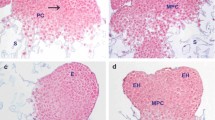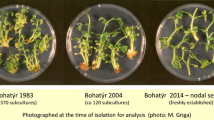Abstract
Dipicolinic acid, a known inhibitor of an enzyme (dihydrodipicolinic acid reductase) in the maize (Zea mays L.) lysine biosynthetic pathway, inhibits the growth of maize suspension and callus cultures. Inhibited cultures contain somewhat lower free lysine levels, but the inhibition of suspension culture growth was not reversible with simultaneous addition of L-lysine to the culture medium. It is concluded that dipicolinic acid does not act solely as an analog blocking lysine production. Dipicolinic acid thus appears to be unsuitable as a selection for maize tissue culture mutants with lysine overproduction.
Similar content being viewed by others
Abbreviations
- FW:
-
fresh weight
- I50 :
-
inhibitor concentration at which cell growth is inhibited by 50%
- MS:
-
Murashige and Skoog (1962) culture medium
- ZM:
-
Black Mexican Zea mays suspension culture of Chourey and Zurawski (1981)
References
Alexander DE, Creech RG (1977) In: Sprague GF (ed) Corn and Corn Improvement, second edition, American Society of Agronomy, Inc., Madison, Wisconsin, pp 363–390
Boyes, CJ, Vasil IK (1987) Plant Sci 50:195–203
Bryan JK (1980) In: Miflin BJ (ed) The Biochemistry of Plants, Vol. 5, Academic Press, New York, pp 403–452
Chourey PS, Zurawski DB (1981) Theor Appl Genet 59:341–344
Duncan DR, Williams ME, Zehr BE, Widholm JM (1985) Planta 165:322–332
Gonzales RA, Das PK, Widholm JM (1984) Plant Physiol 74:640–644
Green CE, Phillips RL (1975) Crop Sci 15:417–421
Hibberd KA, Green CE (1982) Proc Natl Acad Sci USA 79:559–563
Miao SH, Duncan DR, Widholm JM (1988) Plant Cell Tissue Organ Cult, in press
Murashige T, Skoog F (1962) Physiol Plant 15:473–497
Negrutiu I, Cattoir-Reynaerts A, Verbruggen I, Jacobs M (1984) Theor Appl Genet 68:11–20
Tyagi VS, Henke RR, Farkas WR (1983) Plant Physiol 73:687–691
Wakasa K, Widholm JM (1987) Theor Appl Genet 74:49–54
Widholm JM (1972a) Biochim Biophys Acta 261:52–58
Widholm JM (1972b) Biochim Biophys Acta 261:44–51
Widholm JM (1972c) Stain Technology 47:189–194
Widholm JM (1983) In: Sen SK, Giles KL (eds) Plant Cell Culture in Crop Improvement, Plenum Press, pp 71–85
Author information
Authors and Affiliations
Additional information
Communicated by E. D. Earle
Rights and permissions
About this article
Cite this article
Zehr, B.E., Widholm, J.M. The effect of dipicolinic acid on maize tissue culture growth is not solely due to inhibition of lysine biosynthesis. Plant Cell Reports 7, 326–328 (1988). https://doi.org/10.1007/BF00269929
Received:
Revised:
Issue Date:
DOI: https://doi.org/10.1007/BF00269929




